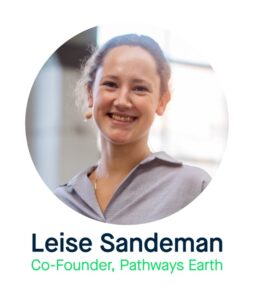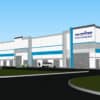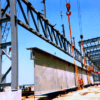If you’re eager to know what the buildings of the future will look like, ask the emerging visionaries specializing in sustainable and smart building solutions, integrated building solutions, and advanced AI robotics — to name a few.
Such professionals are among a select group of innovators taking part in a new accelerator program hosted by BlueScope Buildings North America (a division of the global steel company, BlueScope Steel Ltd.) and its venture arm, BlueScopeX.
Aptly titled, “Buildings of the Future,” the global accelerator, which launched in May 2023, challenges participants to improve the construction industry.
The six-week accelerator invites companies from around the world to immerse themselves as a cohort in weekly learning streams that include mentoring and coaching sessions with industry experts, as well as networking events. It’s all designed to help them build their business, while building the future, and participating companies are thrilled about the opportunity.
“We’re excited to be part of the BlueScope program and be connected with the wider team as we continue to validate our proposition and routes to market,” says participant Rishi Chowdhury, who is the co-founder of Incube Space. “We hope the exposure and access to the network we get provides an opportunity to identify partnerships and proof of concepts that help us accelerate our growth journey.”
Culminating in an interactive live event, the selected companies will pitch their concepts in person at Massachusetts Institute of Technology (MIT) on June 14, 2023, in collaboration with the MIT Startup Exchange.
The winner will be awarded $100,000 USD — no strings attached, and no equity taken.
“This melting pot of founders and accelerator coaches is a true collaboration in action; it’s honest, it’s kind, it’s fun, it’s fast, it’s tough, and from this beautiful tension, the future will emerge,” says Hannah Gee of BlueScopeX, who is leading the design, development, and delivery of the accelerator program. Gee says the accelerator aims to help founders in several key areas:
- Move a pilot project forward
- Give honest feedback so the startup-can iterate
- Advise on commercialization opportunities
- Understand customer development options
- Focus on prioritization
The accelerator’s goal: “To make the building industry more productive, adaptable, and sustainable, strengthen communities, and build a better world,” says Luke Dawson, vice president of strategic marketing for BlueScope Buildings North America (BBNA).
The innovative start-ups taking part in BBNA’s accelerator program are:
1. Gigbridge / Skilled labor solution
2. Pathways Earth / Decarbonization solutions
3. Deep.Meta / Digital twin technology
4. Matrak / Supply chain solutions
5. Defy-Hi Robotics / Building facade solution
6. Sightdata / Workplace safety solutions
7. Incube Space / Building intelligence solutions
8. PT Blink / Prefabricated construction solutions
9. Solar Steel / Zero-energy buildings
Learn more about these innovators below.
 Gigbridge / Skilled labor solution
Gigbridge / Skilled labor solution
One of the biggest challenges the construction industry faces today is finding skilled labor.
Skilled labor shortages in the construction industry have been a growing concern, as companies are struggling to fill a backlog of open positions. In the U.S., the Associated Builders and Contractors says an additional 546,000 workers are needed on top of normal hiring this year. Further complicating the issue is the fact that 41% of American construction workers are expected to retire by 2031, McKinsey reports.
Gigbridge aims to fix that with an online platform that lets companies find and hire skilled talent.
The company is headquartered in the UK, and its SaaS tool and marketplace offer an end-to-end talent solution to find and hire vetted professionals; manage and communicate with a network of subcontractors; manage compliance, documents and reviews; and automate timesheet collection and payments.
Gigbridge founder Gabriel Makinwa recognizes the long-term benefits of participating in a short-term accelerator program. I’m taking part in the BluescopeX program to meet with other construction tech founders and learn more about the challenges facing BBNA’s (BlueScope Buildings North America) network of contractors in the US,” Makinwa says.
 Pathways Earth / Decarbonization solution
Pathways Earth / Decarbonization solution
A sustainability platform for the construction industry, Pathways Earth offers an architecture design tool that lets architects calculate embodied carbon in their designs and minimize the carbon footprint of their projects.
“Pathways Earth helps the building industry measure, map and reduce embodied carbon in materials used for new builds and retrofits. We realized that while embodied carbon is responsible for almost half of a new building’s emission, most focus went to operational carbon (think HVAC and lightbulbs). We wanted to make it easy for builders to reduce the embodied carbon, first by understanding where their material emissions come from. This led to our first product, which integrates directly with architect design tools (3D BIM software) allowing architects to see the environmental impact as they design,” says Pathways Earth co-founder, Leise Sandeman.
40% of global emissions come from the built environment, and of that, half comes from a building’s embodied carbon — the manufacturing, transportation, and installation of materials, the company says on its website.
“While much progress has been made to measure and minimize operational carbon, the other half of carbon emissions, embodied carbon, is still poorly understood.”
The company wants to integrate across the built environment, from industrial material procurement, to building permits, sustainability certification, and ESG reporting.
In the end, Pathways Earth becomes a full-stack sustainability platform for the construction industry to align stakeholders and aid in sustainable decision-making around the built environment.
Sandeman says choosing to participate in the Buildings of the Future accelerator was appealing to Pathways Earth Sandeman says because, “BlueScopeX can give hands-on support because they’re not generalists.”
 Deep.Meta / Digital twin technology
Deep.Meta / Digital twin technology
More than 1.8 billion tons of steel are produced every year and because of production errors, 25% needs to be reworked.
Deep.Meta aims to fix that with an AI-powered digital twin that predicts defects in steel production to reduce waste in manufacturing lines.
“I had the privilege of working closely with a large steel producer during my Ph.D. and could see they followed conventional, and at times, manual approaches to optimize processes and resolve inefficiencies instead of leveraging the significant amount of data they already had. This led me to imagine a world where data-driven, AI-first optimizations could help us make steel with less energy and lower carbon impact,” says Deep.Meta founder, Osas Omoigiade.
“While most people believe the iron age is over, we know that it is stronger than ever,” the company says.
In the steel industry, modern-day plants are equipped with vast numbers of sensors, and UK-based Deep.Meta harnesses that data to optimize production and create digital versions of potential defects. The company’s software provides real-time insights to warn operators of casting cracks, or where target-properties won’t be achieved in a rolling schedule. Deep.Meta aims to reduce scrap rates, energy consumption, and lower the embodied CO₂ in steel.
While the manufacturing industry was one of the first to adopt digital twins, engineers in other industries have now widely adopted digital twins to reduce the weight of structures; plan the use of space; improve infrastructure monitoring of structures; and improve product usability and quality.
“We decided to participate in the (Buildings of the Future) accelerator because we’re interested in connecting with other built environment startups across the globe,” says Omoigiade.
 Matrak / Supply chain solutions
Matrak / Supply chain solutions
Matrak offers an end-to-end SaaS platform that enables tracking and visibility of materials from procurement through to fabrication, and out to distribution and delivery.
The Matrak platform takes user-uploaded static drawings and makes them interactive, as well as generates a bill of materials. The software lets users track builds and project tenders, generate shareable reports in seconds, and its API integrates with existing enterprise and manufacturing systems.
Connecting supply chains has never been so important and so complex. In 2023, supply chain woes have ebbed and flowed in the construction industry, and challenges that were exacerbated by global events are expected to persist for years.
“Asset tracking is an invaluable tool that has helped countless construction projects remain within budget while improving accuracy across many facets, including material management and labor costs,” the company says.
“Providing real-time visibility into each item’s location as well as its condition or status at any given time throughout the duration of a building project can help improve efficiencies related to workflow management and communication between teams.”
According to the Associated General Contractors of America’s 2023 Construction Outlook National Survey, contractors’ biggest concern is the supply chain. Last year, about half of respondents say they turned to alternative suppliers or materials, nearly one quarter (22%) filled inventory with items before winning contracts, and 70% accelerated purchases after winning work.
“Exposure and connection to the BlueScope global industry network and its team’s deep industry expertise made joining the accelerator a no-brainer,” says Matrak co-founder, Shane Hodgkins.
 Defy-Hi Robotics / Building façade solution
Defy-Hi Robotics / Building façade solution
It all started while cleaning windows. After a crew found itself stuck in a broken-down building maintenance unit, Defy-Hi Robotics founder Dr. Abbie Widin began looking for better ways to work.
On commercial buildings, anything that happens on the outside of a building — from window washing to inspections — requires people going over the side of a high-rise to do the job.
Defy-Hi Robotics wanted a safer, more technology-focused solution, so it developed a prototype it calls the BEAR (a synonym for Building Envelope Access Robot). The BEAR helps with functions such as window cleaning, but also uses technology to inspect and capture data for façade inspections where drones can’t fly. The BEAR maps, inspects, and interacts with building surfaces to offer safer, more affordable, and smarter building façade inspections.
“It has never made sense to have humans dangling over the side of a building,” the company says. The BEAR will mean fewer people have to scale up or down the outside of tall buildings, as robotics and data can be used to capture information.
Building façade inspection regulations vary by region, but some now require owners to inspect their buildings more often than historical standards.
In San Francisco, for example, in March of 2023, storms compromised six buildings, and dozens of cracked windows fell to the streets below. As a result, the local building inspection department now requires owners of 15-story buildings or taller built after 1998 to be inspected. The previous rule only affected buildings 30+ years old, but buildings constructed as recently as seven years ago were suffering from failing glass.
Defy-Hi Robotics’ BEAR offers inspection capabilities. Once data is collected, a 3D digital twin of the building is created, and artificial intelligence is used to analyze and localize data.
“We will change the way façade inspections are done by collecting a comprehensive dataset from the entire façade, especially in cities where it is difficult to use drones for legal or operational reasons,” Widin says.
 Sightdata / Workplace safety solutions
Sightdata / Workplace safety solutions
Workplace safety is the number one priority for every construction company. Two years ago, the United States reported construction and extraction occupations having the second highest occupational deaths with slips, trips and falls making up nearly 44% of the 850 fatalities that year.
“Our solution was inspired in response to real safety concerns and injuries on industrial sites,” says Sightdata founder, Ed Muthiah.
Sightdata aims to create safer worksites for all. The Australian company uses artificial intelligence and computer visioning to classify, detect, and track safety incidents, and generate safety reports to drive behavioral change.
By identifying safety incidents and hazards on construction sites in real-time, Sightdata’s objective is to make safety smarter by empowering workers to make informed, data-based decisions that reduce workplace injuries.
Sightdata is excited about participating in the Buildings of the Future accelerator program to learn more about the construction industry and where its solution can benefit individuals who work within the sector.
“We’re eager to learn how best to enter the market and develop business and brand plans. We’ve spoken to companies before, but never hit this level of insight this quickly,” Muthiah says of the BlueScope Buildings of the Future accelerator.
 Incube Space / Building intelligence solutions
Incube Space / Building intelligence solutions
A building should work for its tenants. That’s where UK-based Incube Space comes in — its predictive building intelligence platform manages optimal indoor air quality and space utilization using data. The platform connects building owners to BMS, HVAC, and IoT sensors that enable owners to make predictions based on how the space is being used, as well as provide recommendations on how HVAC can be adapted for tenant comfort and to ensure optimal indoor air quality.
“Before starting Incube Space we were building and designing innovative workspaces to maximize collaborative working in spaces that were inspiring and healthy for occupiers,” says co-founder, Rishi Chowdhury. “We were amazed at how often we came across the same inefficiencies and waste in the commercial real estate industry. The disconnect between tenants, who had the info on how people used the space, and landlords who control the HVAC and lighting, led to huge amounts of energy waste and negative effects on occupiers.”
The Incube Space solution is both needed and timely. According to a 2022 survey, 72% of office workers worldwide worry about air quality in their buildings. Furthermore, many employees will consider leaving if their employers don’t offer clean-air working environments.
To help solve this problem, Incube Space consolidates anonymized data around space utilization and makes certain that the HVAC is only used as and where necessary. This results in less energy waste and a healthier environment for occupiers. Incube Space’s mission is to ensure buildings are healthy places for people and the planet.
PT Blink / Prefabricated construction solutions
PT Blink enables the flexible design, offsite manufacturing, and onsite integration of multi-story buildings.
Based in Australia and the United States, PT Blink’s solution is the “Ikea of construction” where a building’s structure utilizes pre-made steel structures instead of concrete, allowing teams to build faster and construct multiple floors simultaneously.
Prefabrication is not new, but interest is growing as the process helps address many of the challenges faced in the construction industry today — especially the shortage of skilled workers. With prefabrication, structures can be built and erected faster and with fewer people as compared to conventional construction approaches.
In the case of PT Blink, the company says every project is different, but it aims to save builders around 40% of the total project time.
“For owners and developers, if you consider the time value of money, then we can substantially improve their internal rate of return,” the company says. “Shorter project time means less time paying interest, faster time to collect a return on investment, and less risk exposure to things like market shifts.”
In addition to speed to market, prefabrication also reduces construction waste. A 2021 study at the University of South Wales showed that modular construction reduced the weight of waste by more than 80%.
Finally, prefabrication also cuts back on energy use by 67%, a study from engineering and planning firm Arup reports.
“Manufacturers are at the heart of our solution to the construction industry problem, so we jumped at the opportunity to work with a world-leading manufacturer (BlueScope) that is so well aligned with what we are trying to achieve,” says PT Blink founder, Murry Ellen.
 Solar Steel / Zero-energy buildings
Solar Steel / Zero-energy buildings
Founder Dan Harkins has a long history of passion and success in conserving energy needed to operate non-residential buildings. More than 30 years ago, Harkins invented a high R-value insulation system called Simple Saver™ designed for metal buildings, which has been successfully implemented since its inception.
Now Harkins is redirecting that same passion and drive for conserving energy by using the building envelope to generate energy.
Traditional metal building designs have long been rooted in finding ways to repel heat gain caused by the sun. Light-colored reflective roofs are used to repel the sun rays, and thick insulation systems are utilized across the entire building envelope to keep heat gain from impacting the building’s operational efficiency. The Solar Steel solution completely deviates from this concept and welcomes the energy being provided by nature.
Solar panels are not the only way to leverage the sun’s energy, Harkins’ Solar Steel concept aims to efficiently convert sun energy into practical ways to deliver climate-controlled environments, and uses bladeless turbines to generate power based on temperature differential flow.
For most metal buildings, the ridge is the structure’s highest point. Combining this geometric trait with the well-known rule that heat rises, inspired Harkins to create something unique.
Instead of pressing building insulation tight against the exterior envelope, as is traditionally done, the Solar Steel solution creates an air gap (or plenum) between the backside of the exterior envelope cladding and the building insulation system. As the sun beats down upon the cladding, the heat is captured in the gap and rises to the highest point. This is where Harkins finds unique ways to capture this energy and efficiently convert it into practical uses for building operations.
To learn more about the Buildings of the Future accelerator, visit BlueScopeX.io/Accelerator and follow BlueScope Buildings North America (BBNA) on LinkedIn for updates.
Register to attend the in-person pitch session on June 14, 2023, by visiting Eventbrite.










